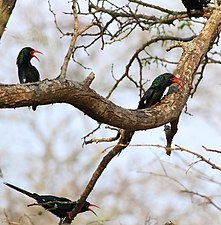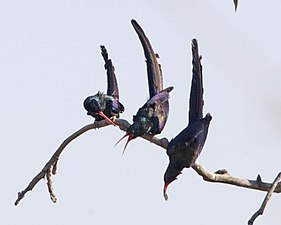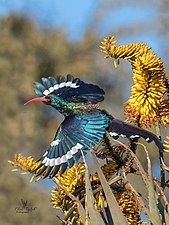Green wood hoopoe
| Green wood-hoopoe | |
|---|---|
Green wood hoopoe at Mapungubwe National Park, Limpopo, South Africa | |
| Chattering calls of P. p. niloticus in the Mtembur area of western Kenya | |
| Scientific classification | |
| Domain: | Eukaryota |
| Kingdom: | Animalia |
| Phylum: | Chordata |
| Class: | Aves |
| Order: | Bucerotiformes |
| Family: | Phoeniculidae |
| Genus: | Phoeniculus |
| Species: | P. purpureus
|
| Binomial name | |
| Phoeniculus purpureus (J.F. Miller, 1784)
| |
The green wood hoopoe (Phoeniculus purpureus) is a large, up to 44 cm (17 in) long tropical bird native to
Taxonomy
In 1784 the English illustrator
Six subspecies are recognised:[3]
- P. p. senegalensis (Vieillot, 1822) – south Senegal to south Ghana
- P. p. guineensis (Reichenow, 1902) – north Senegal and Gambia to Chad and Central African Republic
- P. p. niloticus (Neumann, 1903) – Sudan to west Ethiopia and northeast DR Congo
- P. p. marwitzi (Reichenow, 1906) – east Uganda and Kenya to east South Africa
- P. p. angolensis (Reichenow, 1902) – Angola and west Zambia to northeast Namibia and north Botswana
- P. p. purpureus (Miller, JF, 1784) – central, southwest South Africa
The green wood hoopoe is sometimes considered as
Description
This abundant species is a metallic dark green, with a purple back and very long diamond-shaped purple tail. Distinctive white markings on the wings and white chevrons on the tail edges make it easily identifiable, as does its long, thin, curved red bill. Sexes are similar, but immatures have a black bill.
It advertises its presence with its loud kuk-uk-uk-uk-uk call and other vocalisations.
Behaviour and ecology
Food and foraging
The green wood hoopoe is an insect-eating species. It feeds mainly on the ground, at termite mounds, or on tree trunks, and forms flocks outside the breeding season. Its specialised claws enable it to cling easily to the underside of branches while closely inspecting the bark for insects.
Breeding
The green wood hoopoe is a
Status
Widespread and common throughout its large range, the green wood hoopoe is assessed as
Gallery
-
Chattering family group
-
Chattering and displaying
-
In flight
-
Feeding at aloe flowers in winter
-
Immature fledgling with black bill peeking from old barbet hole
-
P. p. niloticus at Lake Baringo, Kenya
References
- . Retrieved 13 November 2021.
- .
- ^ Rasmussen, Pamela, eds. (January 2022). "Mousebirds, Cuckoo Roller, trogons, hoopoes, hornbills". IOC World Bird List Version 12.2. International Ornithologists' Union. Retrieved 10 June 2022.
- ISBN 978-84-87334-30-6.
- .
- .
- ^ Roberts Bird Guide (2007)
- Birds of The Gambia by Barlow, Wacher and Disley, ISBN 1-873403-32-1









